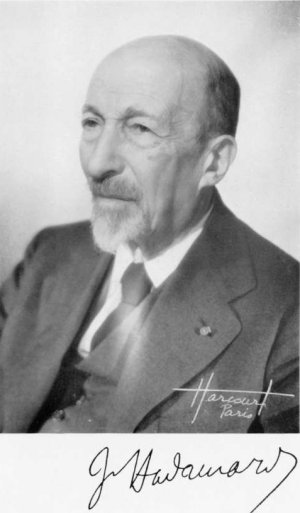Jacques Hadamard (nonfiction): Difference between revisions
No edit summary |
No edit summary |
||
| Line 1: | Line 1: | ||
[[File:Jacques_Hadamard.jpg|thumb|Jacques Hadamard.]]'''Jacques Salomon Hadamard''' ForMemRS (8 December 1865 – 17 October 1963) was a French [[Mathematician (nonfiction)|mathematician]] who made major contributions in number theory, complex function theory, differential geometry and partial differential equations. | [[File:Jacques_Hadamard.jpg|thumb|Jacques Hadamard.]]'''Jacques Salomon Hadamard''' ForMemRS (8 December 1865 – 17 October 1963) was a French [[Mathematician (nonfiction)|mathematician]] who made major contributions in [[Number theory (nonfiction)|number theory]], complex function theory, differential geometry and partial differential equations. | ||
In his book ''Psychology of Invention in the Mathematical Field'', Hadamard uses introspection to describe mathematical thought processes. In sharp contrast to authors who identify language and cognition, he describes his own mathematical thinking as largely wordless, often accompanied by mental images that represent the entire solution to a problem. He surveyed 100 of the leading physicists of the day (approximately 1900), asking them how they did their work. | In his book ''Psychology of Invention in the Mathematical Field'', Hadamard uses introspection to describe mathematical thought processes. In sharp contrast to authors who identify language and cognition, he describes his own mathematical thinking as largely wordless, often accompanied by mental images that represent the entire solution to a problem. He surveyed 100 of the leading physicists of the day (approximately 1900), asking them how they did their work. | ||
Hadamard described the experiences of the mathematicians/theoretical physicists [[Carl Friedrich Gauss (nonfiction)|Carl Friedrich Gauss]], Hermann von Helmholtz, [[Henri Poincaré (nonfiction)|Henri Poincaré]] and others as viewing entire solutions with "sudden spontaneousness". | Hadamard described the experiences of the mathematicians/theoretical physicists [[Carl Friedrich Gauss (nonfiction)|Carl Friedrich Gauss]], [[Hermann von Helmholtz (nonfiction)|Hermann von Helmholtz]], [[Henri Poincaré (nonfiction)|Henri Poincaré]] and others as viewing entire solutions with "sudden spontaneousness". | ||
Hadamard described the process as having four steps of the five-step Graham Wallas creative process model, with the first three also having been put forth by Helmholtz: Preparation, Incubation, Illumination, and Verification. | Hadamard described the process as having four steps of the five-step Graham Wallas creative process model, with the first three also having been put forth by [[Hermann von Helmholtz (nonfiction)|Helmholtz]]: Preparation, Incubation, Illumination, and Verification. | ||
== In the News == | == In the News == | ||
| Line 13: | Line 13: | ||
== Fiction cross-reference == | == Fiction cross-reference == | ||
* [[Mathematics]] | * [[Mathematics]] | ||
| Line 21: | Line 18: | ||
== Nonfiction cross-reference == | == Nonfiction cross-reference == | ||
* [[Maurice René Fréchet (nonfiction)]] - Doctoral student | |||
* [[Carl Friedrich Gauss (nonfiction)]] | |||
* [[Marc Krasner (nonfiction)]] - Doctoral student | |||
* [[Paul Lévy (nonfiction)]] - Doctoral student | |||
* [[Szolem Mandelbrojt (nonfiction)]] - Doctoral student | |||
* [[Mathematics (nonfiction)]] | * [[Mathematics (nonfiction)]] | ||
* [[Number theory (nonfiction)]] | |||
* [[C. Émile Picard (nonfiction)]] - Doctoral advisor | |||
* [[Henri Poincaré (nonfiction)]] | |||
* [[Jules Tannery (nonfiction)]] - Doctoral advisor | |||
* [[Hermann von Helmholtz (nonfiction)]] | |||
* [[André Weil (nonfiction)]] - Doctoral student | |||
External links: | External links: | ||
Revision as of 17:41, 21 November 2017
Jacques Salomon Hadamard ForMemRS (8 December 1865 – 17 October 1963) was a French mathematician who made major contributions in number theory, complex function theory, differential geometry and partial differential equations.
In his book Psychology of Invention in the Mathematical Field, Hadamard uses introspection to describe mathematical thought processes. In sharp contrast to authors who identify language and cognition, he describes his own mathematical thinking as largely wordless, often accompanied by mental images that represent the entire solution to a problem. He surveyed 100 of the leading physicists of the day (approximately 1900), asking them how they did their work.
Hadamard described the experiences of the mathematicians/theoretical physicists Carl Friedrich Gauss, Hermann von Helmholtz, Henri Poincaré and others as viewing entire solutions with "sudden spontaneousness".
Hadamard described the process as having four steps of the five-step Graham Wallas creative process model, with the first three also having been put forth by Helmholtz: Preparation, Incubation, Illumination, and Verification.
In the News
Fiction cross-reference
Nonfiction cross-reference
- Maurice René Fréchet (nonfiction) - Doctoral student
- Carl Friedrich Gauss (nonfiction)
- Marc Krasner (nonfiction) - Doctoral student
- Paul Lévy (nonfiction) - Doctoral student
- Szolem Mandelbrojt (nonfiction) - Doctoral student
- Mathematics (nonfiction)
- Number theory (nonfiction)
- C. Émile Picard (nonfiction) - Doctoral advisor
- Henri Poincaré (nonfiction)
- Jules Tannery (nonfiction) - Doctoral advisor
- Hermann von Helmholtz (nonfiction)
- André Weil (nonfiction) - Doctoral student
External links:
- Jacques Hadamard @ Wikipedia
